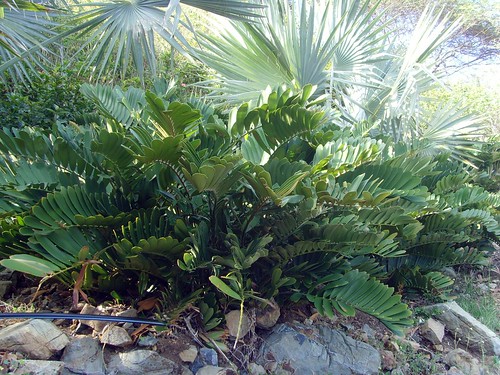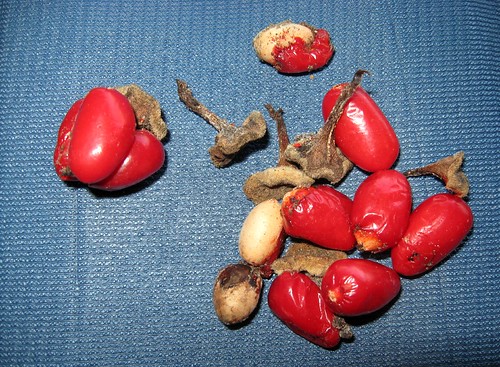
Now having shared the male cones previously, I was delighted to spot a plant pushing 3 female cones. Now I'm always delighted to see coning female cycads because a) that represents a nice healthy mature plant, b) it represents the possibility of seeds and c) the world can never have enough cycad seed in it. Adding to my pleasure was the fact that since I've already covered male Z. furfuracea cones this would be the first "finished" species on the blog ie one with male and female cones and plants represented.

Now while I mentioned the possibility of seeds I wasn't really expecting to see any because even though this was a massed planting and there were almost certainly males coning too cycads generally (and there are exceptions) have very specific pollinators and don't tend to naturally pollinate one another in areas where wild cycads of the same species or at least genus don't exist. Happily I was wrong so I get to show you what a mature female cone with seeds looks like.

Check out the bright red sarcoestra (the fleshy bit)! Of course Zamia seed are rather poisonous but some animals will take them - I know of a couple of Zamia species supposedly dispersed by crabs. I also happened to notice a couple of seeds that had dropped out of the cone and onto the road. Now I'm not one to scrump seeds (or cuttings - taking nail scissors and baggies to botanic or public gardens is seriously not cool people, at least not unless you've asked permission first (I once had this conversation with the sweetest looking little old lady who I'd seen go after Hidcote garden's famous lavenders like Edward Scissorhands) but these were on the road and were absolutely going to go to waste. So...

.....these few made their way home with me. Hopefully the rest of the cone(s) will be collected and put to use before they too disperse under a car. You can see a mix of the cone scales, clean seeds and seeds still with the sarcoestra in the picture. You have to clean this off (wearing suitable protection) before germinating the seeds btw and it stinks. Hopefully I'll share some seedling photos with you at some point in the next few months. Saturday (or today if you are reading this on saturday) I'll share yet more Zamia furfuracea only slightly different.
8 comments:
These are so amazing. I've only ever seen cycads in botanical garden situations. They're very prehistoric and yet so gloriously sophisticated too.
jodi - they really are amazing and I have to say that every time I see one, even a common one like this, there is something remarkably special about their continued survival and success.
My partner is a cycad aficionado. He has grown a whole bunch of Z. furfuracea from seeds that he collected in the Florida Keys some years back. Some of them are now quite large- I was impressed by how quickly they grew.
I have hundreds of our native coontie seeds that I need to peel and scarify.
Good luck with yours!
Thanks Doug - I know Z furfuracea is supposed to go well from seed, especially if in the seedlings end up in the ground as opposed to pots.
FC - yeah I thought of you when I was peeling, hundreds must be disgusting! BTW I know you have 2 or 3 forms of Coontie as part of your coontie baron plan, have you come across the palatka giant form? It looks amazing.
Great plants; however, they have lots of little spines on them! They do well with lots of light and little water.
Thanks for connecting me with info about the cycad plant. Just took 10 shots of this beauty and, now, because of you, I can do more exploring.
Also of interest, FREE one-minute exercise videos at
Exercise Of The Week
Post a Comment